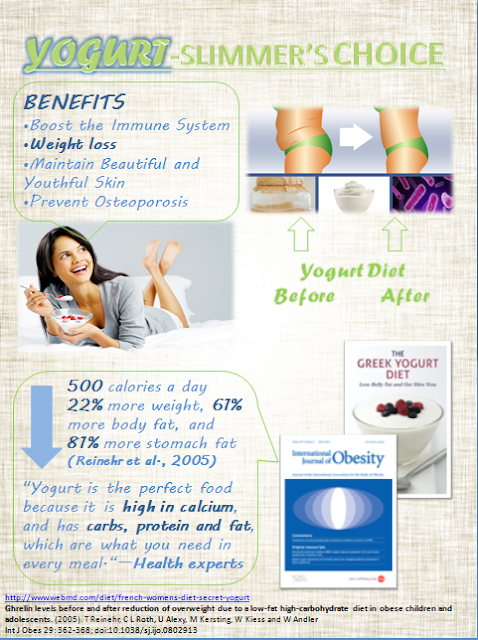Nowadays, there are
an increasing number of people in the world suffering from overweight or
obesity, and all those people would like to find a suitable diet for
themselves. I therefore recommend yogurt to anyone who wants to keep fit by
presenting benefits of yogurts with the specific focus on weight loss. Several
persuasive techniques are applied in the ad above in the attempt to persuade
readers to have more yogurts in their life.
Firstly, visual
persuasion is applied in the ad, which is indicated from the picture depicting the
“before and after” effect of a yogurt diet and the photos of two journals
relevant to yogurt and health. Looking at the picture, one can easily notice
the positive effect of yogurt on weight loss such that the fat on waist would
disappear if constantly adopting the yogurt diet. And the presence of the
scientific journals strengthens the credibility of a yogurt diet. Studies
suggest that visualisation in advertisement is able to enhance the
persuasiveness of messages as it could evoke consumers’ visual argumentation as
well as positive inferences toward the product or the idea being advertised
(Jeong, 2008; McQuarrie and Phillips, 2005). In this way, the visual images can
strongly persuade individuals to drink more yogurts and to see whether they can
also get themselves a slim waist.
Secondly, the
photo of a youthful model shown in the ad conveys another persuasive technique—appearance-based
attractiveness. Trampe et al. (2010) indicated notably high persuasiveness of advertisement
when presenting a physically attractive model in it in which the product is
particularly relevant to physical attractiveness. Consumers tended to hold more
positive attitudes toward the product since they would like to attribute the model’s
beauty to the use of the product and therefore wish themselves the same result.
In this case, the physically attractive model with a bowl of yogurt is very
likely to persuade readers that yogurt can indeed make them prettier and healthier.
The third
persuasive technique involved in this ad is the effect of number. As can be
seen clearly, concrete quantitative results indicating how much weight could be
cut by a yogurt diet were extracted from the study of Reinehr et al. (2005). Research
has claimed that using quantitative messages would probably distract recipients’
attention to the source of the information. And a reliable source, for example,
a source with expertise, could significantly enhance persuasiveness (Yalch and Elmore-Yalch, 1984). The data in the ad above is derived from an academic
study published on the International Journal of Obesity, which is highly likely
to convince readers and persuade them on yogurt consumption.
Last but not
least, photos of the two scientific journals, the statistical evidence, and the
quote from a health expert all stand for the authority of health sciences and
nutriology. Authority is one of the six persuasion principles proposed by
Cialdini (1993), which suggests that people are inclined to go along with the
authority in the corresponding domain usually with the uniformed symbol, for
instance, doctors, police officers, judges, etc. In the ad, the journals, the
study and the word “health experts” all remind readers of authority symbols
regarding the field of food and diet. Hence, people can be persuaded more to consider
yogurt.
So, here are the
four persuasive techniques—visual persuasion, appearance-based attractiveness,
number, and authority. Now go grab some yogurt to benefit your body and for
weight loss.
References
Cialdini, R. (1993). Influence:
The Psychology of Persuasion. New York: Morrows.
Jeong, S. (2008). Visual Metaphor in Advertising: Is the
Persuasive Effect Attributable to Visual Argumentation or Metaphorical Rhetoric? Journal of Marketing
Communications, 14,
59-73.
McQuarrie, E. &
Phillips, B. (2005). Indirect
persuasion in advertising: How consumers process metaphors presented in pictures
and words. Journal of
Advertising, 34,
7-20.
Reinehr, T., Roth, C., Alexy, U.,
Kersting, M., Kiess, W., & Andler, W. (2005). Ghrelin levels before and
after reduction of overweight due to a low-fat high-carbohydrate diet in obese
children and adolescents. International Journal
of Obesity, 29, 362-368.
Trampe, D., Stapel, D., Siero, F., &
Multer, H. (2010). Beauty as a tool: The effect of model attractiveness,
product relevance, and elaboration likelihood on advertising
effectiveness. Psychology and
Marketing, 27, 1101-1121.
Yalch, R. & Elmore-Yalch, R. (1984). The effect
of numbers on the route to persuasion. Journal
of Consumer Research, 11,
522–527.


No comments:
Post a Comment
Note: Only a member of this blog may post a comment.